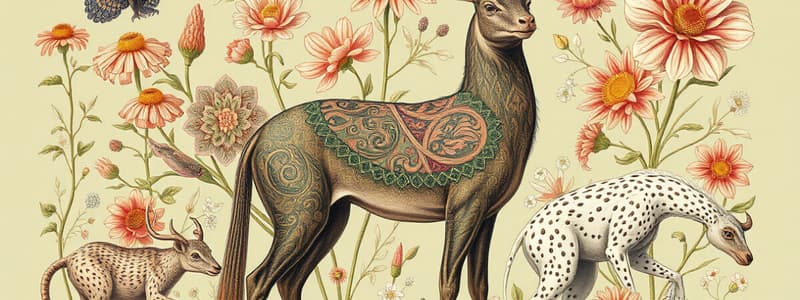Podcast
Questions and Answers
What is a species?
What is a species?
- The name of a specific animal.
- A type of plant.
- An ecosystem of living organisms.
- A group of animals that are more like each other than they are like any other group of animals. (correct)
What does classification refer to in biological terms?
What does classification refer to in biological terms?
- The habitat where species are found.
- A specific type of animal.
- A method of studying animal behavior.
- The process of sorting through all the species to organize them by similar properties. (correct)
Warm-blooded animals can make their own body heat even when it is cold outside.
Warm-blooded animals can make their own body heat even when it is cold outside.
True (A)
Cold-blooded animals can regulate their body temperature regardless of the environment.
Cold-blooded animals can regulate their body temperature regardless of the environment.
What is the definition of 'property'?
What is the definition of 'property'?
Which of the following describes invertebrates?
Which of the following describes invertebrates?
Which of the following are considered vertebrates?
Which of the following are considered vertebrates?
Mammals give birth to live young and nourish them with milk.
Mammals give birth to live young and nourish them with milk.
Fish lay eggs in water with a ______ shell.
Fish lay eggs in water with a ______ shell.
Match the following groups with their characteristics:
Match the following groups with their characteristics:
Which of the following is an example of an amphibian?
Which of the following is an example of an amphibian?
Flashcards are hidden until you start studying
Study Notes
Animal Classification
-
Species: A group of animals that share common characteristics and resemble each other more than they do other groups.
-
Classification: The systematic process of organizing living things into categories based on similarities and common ancestry.
Temperature Regulation
-
Warm-blooded: Animals that maintain their own body heat regardless of external temperatures (e.g., mammals, birds like elephants and eagles).
-
Cold-blooded: Animals whose body temperature varies with the environment (e.g., reptiles, amphibians, fish).
Animal Groups
-
Invertebrates: Animals lacking a backbone, including molluscs, sponges, arthropods, worms, and jellyfish.
-
Vertebrates: Animals with a backbone, divided into categories such as mammals, fish, birds, reptiles, and amphibians.
Mammals
-
Definition: Warm-blooded vertebrates that nourish young with milk from mammary glands; usually have hair and give birth to live young.
-
Characteristics:
- Have four limbs (except whales)
- Possess seven neck bones (except sea cows and sloths)
- Breathe using lungs
- Can sweat or pant to release heat
- Young mammals learn from their mothers
-
Mammal Examples: Dolphins, whales, humans, dogs, cats, horses, kangaroos, lions, tigers, giraffes, elephants, bats, and polar bears.
Birds
-
Definition: Warm-blooded vertebrates that lay eggs with hard shells, covered in feathers, typically with the ability to fly.
-
Characteristics:
- Two limbs adapted for flight, beaks, vertebrae, and hollow bones.
-
Bird Examples: Ravens, eagles, hawks, owls, ducks, geese, swans, penguins, and ostriches.
Fish
-
Definition: Cold-blooded vertebrates living in water, characterized by gills for breathing, fins for movement, and scaly bodies.
-
Characteristics:
- Usually lay eggs with soft shells
- Have no limbs, only fins
- Some have cartilage-based skeletons
-
Fish Examples: Piranhas, seahorses, sharks, whale sharks, lion fish. Notable non-fish include whales and dolphins (which are mammals).
Reptiles
-
Definition: Cold-blooded, air-breathing vertebrates that typically lay eggs with leathery shells, have skin covered with scales.
-
Characteristics:
- Can have no legs or four legs with claws
- Breathe using lungs
-
Reptile Examples: Snakes, lizards, crocodiles, alligators, turtles.
Arthropods
-
Definition: Invertebrates with segmented bodies, hard exoskeletons, jointed limbs, and usually cold-blooded.
-
Characteristics:
- Show diversity with many classes (11 in total)
- Most have the ability to fly
- Breathe through tubes
-
Arthropod Examples: Spiders, millipedes, ants, bumblebees, crabs, centipedes, mites, ticks, shrimp, krill, scorpions, barnacles.
Amphibians
-
Definition: Cold-blooded vertebrates capable of living both in water and on land, often seen as a transition between fish and reptiles.
-
Characteristics:
- Lay unshelled eggs
- Typically include frogs and salamanders.
Studying That Suits You
Use AI to generate personalized quizzes and flashcards to suit your learning preferences.




